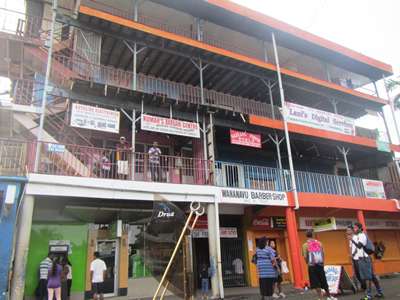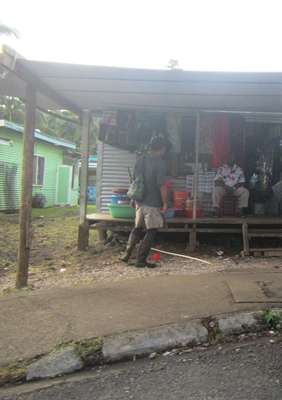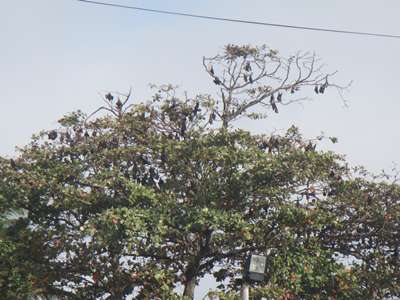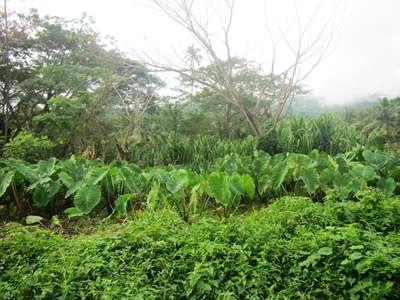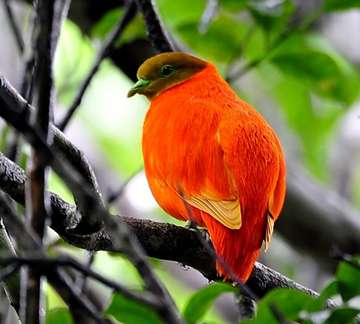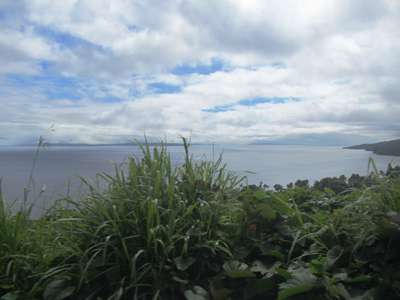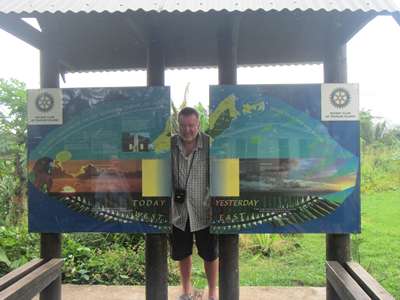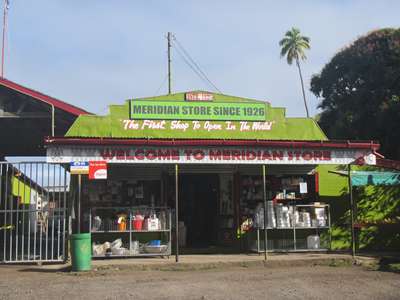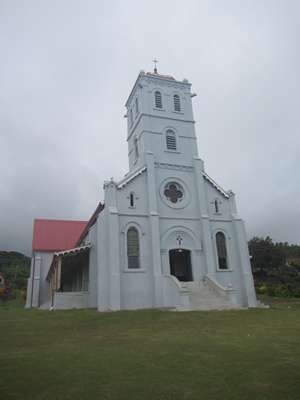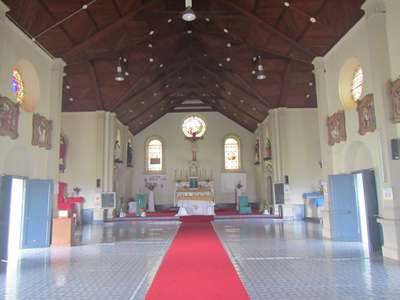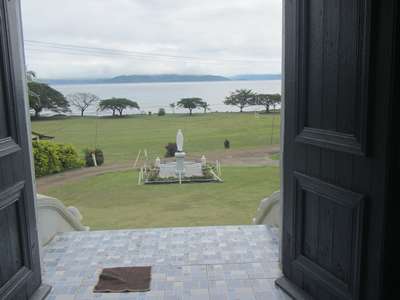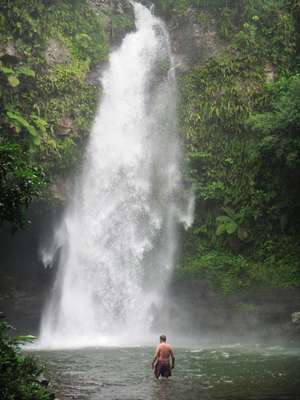Exploring Taveuni

Monday 6th July 2015 We were ashore bright and early to meet the Chief. He turned up promptly in his 4WD, but unfortunately he could not take us out as he had to take his wife to the hospital, he explained. As another car pulled alongside us, he explained that he had arranged for another driver to take us instead. We were a little disappointed that this car was rather small and not 4WD as we had heard that very little of the road here is sealed. We had also heard that the Chief had lots to tell about the island, and hoped that our replacement guide would do so too. We explained where we wanted to go and see, piled into the car and off we went. Our disappointment grew as the driver had very little to say, and seemed unable to answer our questions or to point out anything of interest other than the local high school he had attended. So we resorted to our Lonely Planet for information. We drove south along the west coast road and through the main village of Somosomo, where the interisland ferry calls, and where the only biggish supermarket on the island, an MH, is. We said we might stop there on the way back, and kept on going.
Shopping centre in Somosomo. Only ATM on the island. Roadside shop in Somosomo. Our first stop was at the petrol station, the only one the island, and where we joined a queue of five cars. The driver suggested we get out and go and look at the fruit bats in the nearby tree while he fuelled up.
Fruit bats. We continued south along a road that got bumpier and muddier as the rain started, on our way to see a rare orange dove, we hoped, at a conservation farm about forty minutes’ drive away. We passed lush green countryside and well-laid out gardens around all the houses.
Taro has been planted here and is doing very well. Eventually we arrived at Nabogiono Farm and by now the rain was teeming down. We were in two minds whether to wait a while or carry on, but the rain seemed to be set in for a while, and the lady who greeted us assured us they had umbrellas, so we decided to carry on. We were somewhat shocked to discover that an hour of looking for birds would cost us FJ$40 (£13) each, but were keen to see the orange dove and looked forward to hearing all about the bird life here, so paid up. The lady who took us round gave us no introductory talk, no explanation of the work of the farm which is a conservation project, and no information on the birds. She whistled into the trees and found us an orange dove, which was the highlight of the visit. We spent the rest of the hour under broken umbrellas, fighting off hundreds of mosquitoes, tramping through very wet undergrowth, and saw two more birds – a many-coloured fruit dove and another orange dove (or it may have been the same one in another tree!) Well before we reached this point I had decided I had donated enough blood to the mosquito population (in spite of having covered myself in anti-bug spray!) and had sought refuge in the car where I had to wake up the driver to let me in. The birdwatching over, Steve, Pepe and Bear were led back to the house, where the lady ‘guide’ disappeared inside. They stood looking at each other for a few minutes before deciding that must be the end of the tour, and came and joined me in the car. The engine was on and we were about to pull away when she reappeared with a tray of lemonade for us. We concluded that she must have very little English and therefore limited ability to communicate. We were fast concluding the same about our driver who otherwise might have translated for us. All in all we felt we had received very little value for money, but on the bright side, we had seen the orange dove, so it wasn’t all bad. (We have since been in touch with the owner of the farm by email and he was very apologetic, but explained that we should have booked in advance so that a guide would be arranged for us. The lady who showed us around did so in order that we would not be disappointed after our journey there. We replied that we were grateful to her for doing so, and thanked him, but also pointed out that in the absence of a guide, charging the full rate to see the birds was perhaps not appropriate.)
The orange dove with bright orange body and green head... seen more clearly in this close up by Pepe.
The many-coloured fruit dove (again, thanks to Pepe for close-up!) We had hoped our next stop would be a blowhole at the southern end of the island where there is also a dive resort where we could get some refreshment, but the driver was very reluctant to drive further south for another forty minutes in the worsening road conditions, and so we had to settle to return to Somosomo or Matei to find lunch, and then continue round the top of the island to the waterfalls on the other side. We retraced our route back up to Matei, deciding not to stop at the supermarket as we mainly wanted fresh stuff and had no cooler bag to put it in, and declining the driver’s offer to stop at the souvenir stores in Somosomo.
Looking across the Somosomo Strait towards Viani Bay. We stopped at a point where the 180 meridian passes through the island, and could not resist the temptation to do the usual of standing astride the meridian so that our left and right sides were in different hemispheres on different days. It was somewhat different from the laser line they have at the zero meridian at Greenwich these days, being in a field off a dirt road, but the feeling of accomplishment was not in any way diminished by that – we have sailed halfway around the world to be here.
Steve standing astride the 180 meridian, the international dateline. This little store makes much of being the first over the dateline. We then stopped at the Wairiki Catholic church which stands back impressively from the road on a slope, overlooking the Somosomo Strait. This had the most ornate interior we have seen so far in Fiji, with stained glass windows. No pews though, the congregation sits on woven mats on the floor.
Wairiki Catholic Mission An impressive interior – high wooden beams and stained glass windows.
The view from the church out over the Somosomo Strait to Vanua Levu. By the time we reached Matei, we were ready for lunch. The first place the driver took us told us their restaurant was closed, so we ended up at the Coconut Grove which is a guesthouse on the shore with a restaurant overlooking the anchorage. Here we had a good lunch in very pleasant surroundings looking out at the yachts.
S-F and BN from the restaurant at the Coconut Grove. Fortified and dried out, we returned to the car and set off along the east coast road for the waterfalls. This side of the island is mainly Bouma National Heritage Park, and the waterfalls are within the park. The roads are not sealed and it was another slow and bumpy ride. The visibility from the shore was so poor that we could not even see Qamea, the neighbouring island, only a couple of miles away. When we arrived at the Tavoro waterfalls, it was a wet but pleasant 10-minute walk from the visitor centre to the falls. The first waterfall is 24 metres high and was gushing enthusiastically. Steve and Bear decided to take a swim in the pool, but Pepe and I decided we were wet enough already and would watch from the shelter.
Steve about to take the plunge. Shall I or shan’t I?... A short, refreshing dip later, the men rejoined us and we made our way back to the car. There are two more waterfalls here at Tavoro, but the Lonely Planet speaks of “a good 40-minute, leg-punishing climb up and down hills to the second one” and “as you approach the waterfall you’ll have to make like a frog and jump from boulder to boulder to cross a river”. Given our day so far, we decided against it and simply took the LP’s word that it is “more secluded and beautiful”. Another day maybe. By the time we reached the car in the teeming rain, we might just as well have gone for a swim fully clothed. We wanted to be sure to be back at the dinghy with plenty of light left in the day as returning to the boat involved skirting around one of the reefs we were parked behind, so we headed off back to Matei. We asked the driver to stop outside the shop in Matei, paid him and bade him goodbye. We hoped not to meet up with the Chief as we were very wet and a little fed up, and just wanted to get back to the boat. When we came out of the shop, however, there he was, asking if we’d had a good day and did we want to go and drink kava with him? Pepe did an excellent job of politely declining his invitation and explaining that we really had needed a 4WD car and a more helpful driver to make the most of the day, and as we were very wet, needed to get home. We suspect it fell on deaf ears, though, in his disappointment at not getting any kava. The day’s events were topped off by finding the tide so low that we had to paddle our way through much of the reef before being able to put the outboard down and finally head back to the boats. On the bright side, if we had left it any later, we may well have had to climb out in the middle of the reef and carry the dinghy over it! It had certainly been a very long and full day, and looking back over it in dry clothes, in the warmth of the boat, with a beer in hand, on the whole it had been a good one. It could have been better, but, hey, them’s the breaks eh? |
